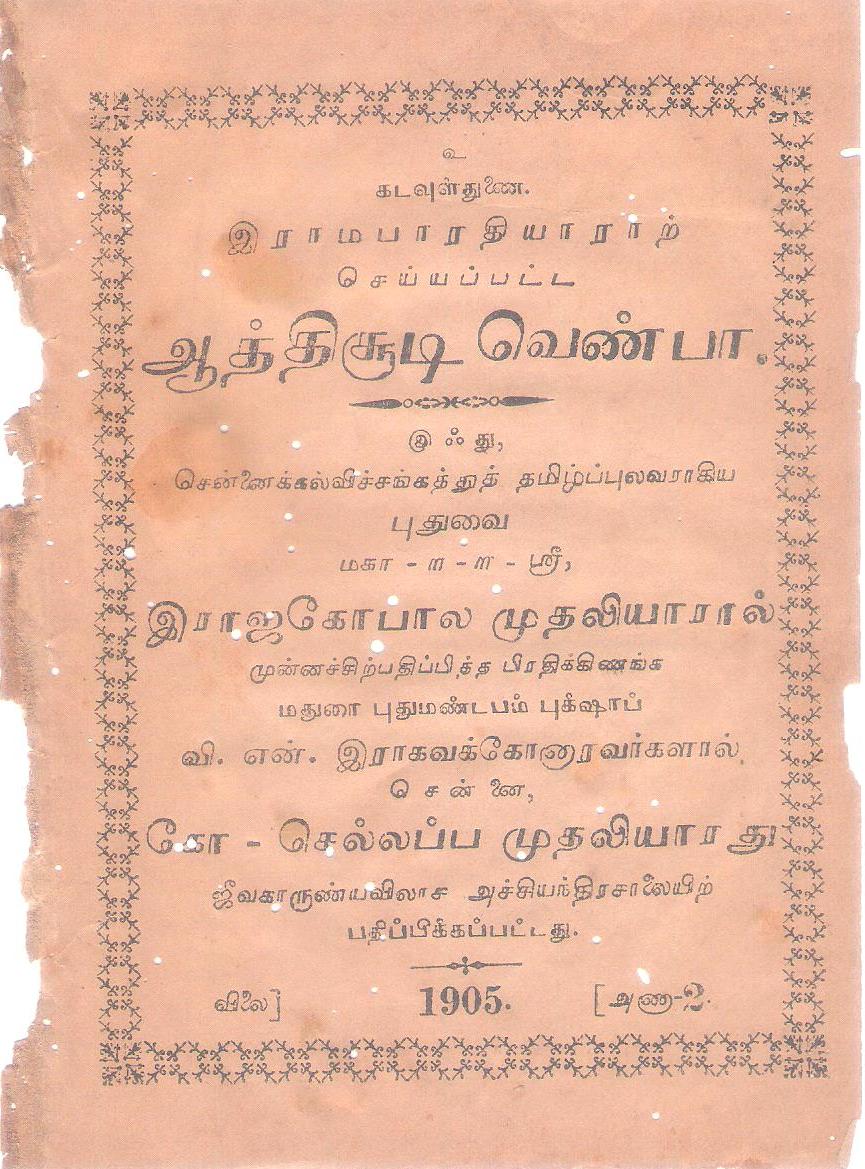|
Venpa
Venpa or Venba ('' வெண்பா'' in Tamil) is a form of classical Tamil poetry. Classical Tamil poetry has been classified based upon the rules of metric prosody. Such rules form a context-free grammar. Every venba consists of between two and twelve lines. The venpa meter is used in songs of the types neṭu veṇ pāṭṭu ('long song in venpa meter'), kuṟu veṇ pāṭṭu 'short song in venpa meter', kaikkiḷai "one-sided love," and paripāṭṭu 'song that is quite accommodative' and in satirical compositions (aṅkatac ceyyuḷ). Popular books written in venba style # All 1330 couplets from the Thirukkural, composed by Thiruvalluvar, are examples of venba. Tirukkural comes under a sub-category of venba called Kural venba, wherein each kural or couplet has only two lines. # Nala venba 1 is another classical work written in venba style. # Niti venba 2 is another venba style book that preaches values. # Acharakkovai 3 is another venba style book that preaches va ... [...More Info...] [...Related Items...] OR: [Wikipedia] [Google] [Baidu] |
Tirukkural
The ''Tirukkuṟaḷ'' ( ta, திருக்குறள், lit=sacred verses), or shortly the ''Kural'' ( ta, குறள்), is a classic Tamil language text consisting of 1,330 short couplets, or Kural (poetic form), kurals, of seven words each. The text is divided into three books with aphoristic teachings on virtue (''aram''), wealth (''porul'') and love (''inbam''), respectively. Considered one of the greatest works ever written on ethics and morality, it is known for its universality and secularity, secular nature. Its authorship is traditionally attributed to Thiruvalluvar, Valluvar, also known in full as Thiruvalluvar. The text has been dated variously from 300 BCE to 5th century CE. The traditional accounts describe it as the last work of the third Sangam literature, Sangam, but linguistic analysis suggests a later date of 450 to 500 CE and that it was composed after the Sangam period. The Kural text is among the earliest systems of Indian epistemology and meta ... [...More Info...] [...Related Items...] OR: [Wikipedia] [Google] [Baidu] |
Syllable
A syllable is a unit of organization for a sequence of speech sounds typically made up of a syllable nucleus (most often a vowel) with optional initial and final margins (typically, consonants). Syllables are often considered the phonological "building blocks" of words. They can influence the rhythm of a language, its prosody, its poetic metre and its stress patterns. Speech can usually be divided up into a whole number of syllables: for example, the word ''ignite'' is made of two syllables: ''ig'' and ''nite''. Syllabic writing began several hundred years before the first letters. The earliest recorded syllables are on tablets written around 2800 BC in the Sumerian city of Ur. This shift from pictograms to syllables has been called "the most important advance in the history of writing". A word that consists of a single syllable (like English ''dog'') is called a monosyllable (and is said to be ''monosyllabic''). Similar terms include disyllable (and ''disyllabic''; also '' ... [...More Info...] [...Related Items...] OR: [Wikipedia] [Google] [Baidu] |
George Uglow Pope
George Uglow Pope (24 April 1820 – 11 February 1908), or G. U. Pope, was an Anglican Christian missionary and Tamil scholar who spent 40 years in Tamil Nadu and translated many Tamil texts into English. His popular translations included those of the Tirukkural and Thiruvasagam. He later took to teaching, running his own school in Ootacamund for while and then moving to head the Bishop Cotton Boys' School in Bangalore and after returning to England worked as a Lecturer at Balliol College, Oxford. A statue on the Chennai beach recognizes him for his contribution to the understanding and promotion of the Tamil language. Biography George Uglow Pope was born on 24 April 1820 in Bedeque, Prince Edward Island in Canada. His father was John Pope (1791–1863), of Padstow, Cornwall, a merchant who became a missionary, who emigrated to Prince Edward Island in 1818, and Catherine Uglow (1797–1867), of Stratton, north Cornwall. The family moved to Nova Scotia, St. Vincent's befo ... [...More Info...] [...Related Items...] OR: [Wikipedia] [Google] [Baidu] |
Tamil Grammar
Much of Tamil grammar is extensively described in the oldest available grammar book for Tamil, the ''Tolkāppiyam'' (dated between 300 BCE and 300 CE). Modern Tamil writing is largely based on the 13th century grammar '' Naṉṉūl'', which restated and clarified the rules of the Tolkāppiyam with some modifications. Parts of Tamil grammar Traditional Tamil grammar consists of five parts, namely eḻuttu, sol, poruḷ, yāppu, and aṇi. Of these, the last two are mostly applicable in poetry. The following table gives additional information about these parts. ''Eḻuttu'' (writing) defines and describes the letters of the Tamil alphabet and their classification. It describes the nature of phonemes and their changes with respect to different conditions and locations in the text. ''Sol'' defines the types of the words based on their meaning and the origin. It defines the gender, number, cases, tenses, classes, harmony, etc. This chapter also provides rules for compounding the ... [...More Info...] [...Related Items...] OR: [Wikipedia] [Google] [Baidu] |
Extended Backus–Naur Form
In computer science, extended Backus–Naur form (EBNF) is a family of metasyntax notations, any of which can be used to express a context-free grammar. EBNF is used to make a formal description of a formal language such as a computer programming language. They are extensions of the basic Backus–Naur form (BNF) metasyntax notation. The earliest EBNF was developed by Niklaus Wirth, incorporating some of the concepts (with a different syntax and notation) from Wirth syntax notation. Today, many variants of EBNF are in use. The International Organization for Standardization adopted an EBNF Standard, ISO/IEC 14977, in 1996. According to Zaytsev, however, this standard "only ended up adding yet another three dialects to the chaos" and, after noting its lack of success, also notes that the ISO EBNF is not even used in all ISO standards. Wheeler argues against using the ISO standard when using an EBNF and recommends considering alternative EBNF notations such as the one from the W ... [...More Info...] [...Related Items...] OR: [Wikipedia] [Google] [Baidu] |
Backus–Naur Form
In computer science, Backus–Naur form () or Backus normal form (BNF) is a metasyntax notation for context-free grammars, often used to describe the syntax of languages used in computing, such as computer programming languages, document formats, instruction sets and communication protocols. It is applied wherever exact descriptions of languages are needed: for instance, in official language specifications, in manuals, and in textbooks on programming language theory. Many extensions and variants of the original Backus–Naur notation are used; some are exactly defined, including extended Backus–Naur form (EBNF) and augmented Backus–Naur form (ABNF). Overview A BNF specification is a set of derivation rules, written as ::= __expression__ where: * is a ''nonterminal'' (variable) and the __expression__ consists of one or more sequences of either terminal or nonterminal symbols; * means that the symbol on the left must be replaced with the expression on the right. * mor ... [...More Info...] [...Related Items...] OR: [Wikipedia] [Google] [Baidu] |
Juxtaposition (literary)
Juxtaposition is an act or instance of placing two elements close together or side by side. This is often done in order to compare/contrast the two, to show similarities or differences, etc. Speech Juxtaposition in literary terms is the showing contrast by concepts placed side by side. An example of juxtaposition are the quotes "Ask not what your country can do for you; ask what you can do for your country", and "Let us never negotiate out of fear, but let us never fear to negotiate", both by John F. Kennedy, who particularly liked juxtaposition as a rhetorical device. Jean Piaget specifically contrasts juxtaposition in various fields from syncretism, arguing that "juxtaposition and syncretism are in antithesis, syncretism being the predominance of the whole over the details, juxtaposition that of the details over the whole". Piaget writes: In grammar, juxtaposition refers to the absence of linking elements in a group of words that are listed together. Thus, where English uses ... [...More Info...] [...Related Items...] OR: [Wikipedia] [Google] [Baidu] |
Iamb (foot)
An iamb () or iambus is a metrical foot used in various types of poetry. Originally the term referred to one of the feet of the quantitative meter of classical Greek prosody: a short syllable followed by a long syllable (as in () "beautiful (f.)"). This terminology was adopted in the description of accentual-syllabic verse in English, where it refers to a foot comprising an unstressed syllable followed by a stressed syllable (as in ''abóve''). Thus a Latin word like , because of its short-long rhythm, is considered by Latin scholars to be an iamb, but because it has a stress on the first syllable, in modern linguistics it is considered to be a trochee. Etymology R. S. P. Beekes has suggested that the grc, ἴαμβος ''iambos'' has a Pre-Greek origin. An old hypothesis is that the word is borrowed from Phrygian or Pelasgian, and literally means "Einschritt", i. e., "one-step", compare ''dithyramb'' and ''thriambus'', but H. S. Versnel rejects this etymology and sugg ... [...More Info...] [...Related Items...] OR: [Wikipedia] [Google] [Baidu] |
Metrical Foot
The foot is the basic repeating metre (poetry), rhythmic unit that forms part of a line of poetry, verse in most Indo-European languages, Indo-European traditions of poetry, including English accentual-syllabic verse and the quantitative meter of classics, classical ancient Greek poetry, ancient Greek and Latin poetry. The unit is composed of syllables, and is usually two, three, or four syllables in length. The most common feet in English are the Iamb (foot), iamb, trochee, dactyl (poetry), dactyl, and anapest. The foot might be compared to a Bar (music), bar, or a beat (music), beat divided into pulse groups, in musical notation. The English word "foot" is a translation of the Latin term ''pes'', plural ''pedes'', which in turn is a translation of the Ancient Greek ποῦς, pl. πόδες. The Ancient Greek prosodists, who invented this terminology, specified that a foot must have both an arsis and thesis, arsis and a thesis, that is, a place where the foot was raised ("arsis") ... [...More Info...] [...Related Items...] OR: [Wikipedia] [Google] [Baidu] |







